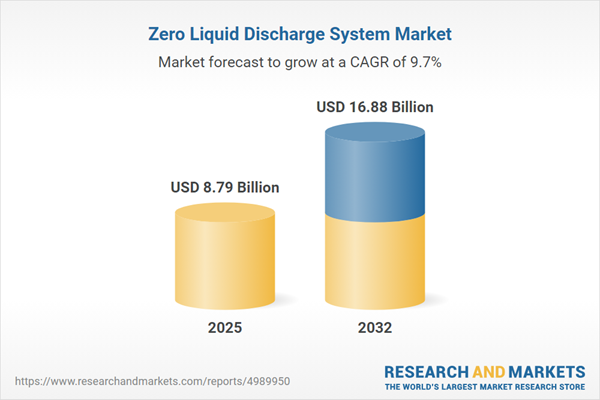Speak directly to the analyst to clarify any post sales queries you may have.
Zero Liquid Discharge systems have become central to industrial water strategies, evolving from compliance solutions to core enterprise assets. Increasing regulatory requirements, rising operational complexity, and the drive for integrated sustainability place Zero Liquid Discharge at the forefront of critical decision-making for senior leadership.
Market Snapshot: Zero Liquid Discharge System Market
The Zero Liquid Discharge System Market grew from USD 8.04 billion in 2024 to USD 8.79 billion in 2025. It is projected to maintain a robust CAGR of 9.69%, ultimately reaching USD 16.88 billion by 2032.
Scope & Segmentation
- Type: Conventional ZLD System, Hybrid ZLD System
- Technology Type: Distillation, Electrodialysis, Forward Osmosis, Reverse Osmosis, Ultrafiltration
- System Component: Centrifuges, Crystallizers, Evaporators, Heat Exchangers, Membranes, Pipes & Tanks, Pumps
- Capacity: 100-500 m³/day, Less Than 100 m³/day, More Than 500 m³/day
- End User: Chemical & Petrochemical, Energy & Power, Food & Beverage, Mining & Metallurgy, Municipal/Public Sector, Oil & Gas, Pharmaceutical, Semiconductor & Electronics, Textile
- Regions: Americas (United States, Canada, Mexico, Brazil, Argentina, Chile, Colombia, Peru), Europe, Middle East & Africa (United Kingdom, Germany, France, Russia, Italy, Spain, Netherlands, Sweden, Poland, Switzerland, United Arab Emirates, Saudi Arabia, Qatar, Turkey, Israel, South Africa, Nigeria, Egypt, Kenya), Asia-Pacific (China, India, Japan, Australia, South Korea, Indonesia, Thailand, Malaysia, Singapore, Taiwan)
- Key Companies: Alfa Laval Corporate AB, Aquatech International LLC, Arvind Envisol Limited, Condorchem Envitech, Fluence Corporation Limited, GEA Group AG, General Electric Company, Gradiant Corporation, H2O GmbH, IDE Technologies, Kurita America Inc., Larsen & Toubro Limited, Lenntech B.V., McWong Environmental Technology Corp. Ltd., Memsys Water Technologies GmbH, Oasys Water, Inc., Petro Sep Corporation, Praj Industries Ltd., Saltworks Technologies Inc., Samco Technologies, Inc., Toshiba Infrastructure Systems & Solutions Corporation, Veolia Water Solutions & Technologies
Key Takeaways for Senior Decision-Makers
- Zero Liquid Discharge is increasingly viewed as an integrated asset, supporting both compliance and energy optimization, while enabling circular water strategies within enterprise frameworks.
- Hybrid system adoption and modular deployments help organizations align capital spending with evolving operational and regulatory needs, reducing risks over time.
- Technological convergence, including enhancements in membrane science and process digitalization, makes ZLD systems more adaptable, energy-efficient, and suitable for phasing as operations scale.
- End-user industries, from pharmaceuticals to mining and semiconductors, require tailored ZLD solutions that address unique influent characteristics and prioritize system reliability and lifecycle cost control.
- Vendor partnerships, particularly those offering outcome-based contracts and strong aftersales support, are becoming decisive factors in procurement, especially for facilities with critical process continuity requirements.
Tariff Impact on Procurement Resilience
- Recent trade measures and tariffs have increased sourcing complexity for ZLD components, influencing vendor selection, lead times, and supply-chain strategies.
- Facilities are adapting by qualifying alternative suppliers and considering regional manufacturing to mitigate procurement risks and contract for supply chain stability.
- Long-term planning has evolved, emphasizing supply certainty and robustness in maintenance planning, while contract terms now increasingly address price escalation and inventory management to weather trade volatility.
Methodology & Data Sources
This report is based on combined qualitative and quantitative analysis, including in-depth interviews with industry stakeholders, detailed technical reviews, and cross-validated secondary research. Vendor technical claims, operational case studies, and scenario analyses underpin the assessment, ensuring practical guidance for both engineering and commercial teams.
Why This Report Matters
- Offers actionable intelligence to align technology decisions, procurement strategy, and operational planning in the Zero Liquid Discharge System Market.
- Enables senior leaders to benchmark regional best practices, enhance supply-chain resilience, and leverage innovation for competitive differentiation.
- Facilitates integration of regulatory, engineering, and sustainability priorities into long-term investment planning.
Conclusion
The Zero Liquid Discharge System Market demands integrated, regionally informed strategies that bridge technology, supply-chain, and operational factors. Senior decision-makers who align these elements position their organizations for regulatory certainty, resilience, and sustainable growth.
Additional Product Information:
- Purchase of this report includes 1 year online access with quarterly updates.
- This report can be updated on request. Please contact our Customer Experience team using the Ask a Question widget on our website.
Table of Contents
3. Executive Summary
4. Market Overview
7. Cumulative Impact of Artificial Intelligence 2025
Companies Mentioned
The companies profiled in this Zero Liquid Discharge System market report include:- Alfa Laval Corporate AB
- Aquatech International LLC
- Arvind Envisol Limited
- Condorchem Envitech
- Fluence Corporation Limited
- GEA Group AG
- General Electric Company
- Gradiant Corporation
- H2O GmbH
- IDE Technologies
- Kurita America Inc.
- Larsen & Toubro Limited
- Lenntech B.V.
- McWong Environmental Technology Corp., Ltd.
- Memsys Water Technologies GmbH
- Oasys Water, Inc.
- Petro Sep Corporation
- Praj Industries Ltd.
- Saltworks Technologies Inc.
- Samco Technologies, Inc.
- Toshiba Infrastructure Systems & Solutions Corporation
- Veolia Water Solutions & Technologies
Table Information
| Report Attribute | Details |
|---|---|
| No. of Pages | 189 |
| Published | November 2025 |
| Forecast Period | 2025 - 2032 |
| Estimated Market Value ( USD | $ 8.79 Billion |
| Forecasted Market Value ( USD | $ 16.88 Billion |
| Compound Annual Growth Rate | 9.6% |
| Regions Covered | Global |
| No. of Companies Mentioned | 23 |









